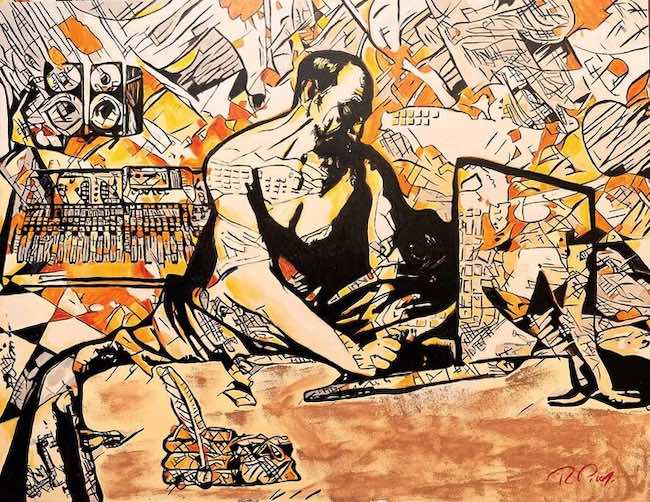Molto spesso l’arte contemporanea sembra voler in qualche modo allontanare la classicità, quella tradizione creativa ed esecutiva attraverso la quale i maestri dei secoli scorsi hanno lasciato testimonianza della loro interpretazione di uno stile accademico fortemente legato alla ricerca estetica, dove i soggetti avevano chiari riferimenti a temi prevalentemente religiosi o mitologici molto lontani dall’orientamento artistico attuale. Eppure, malgrado questo atteggiamento prevalente, vi sono alcuni autori che sentono il bisogno non solo di ricordarlo quel passato, bensì anche di reinterpretarlo in virtù della lente soggettiva e dell’esperienza creativa succeduta a studio, analisi e approfondimento di tutti i percorsi creativi precedenti a quello del presente. Il protagonista di oggi si muove su questa linea espressiva, dando in alcune tele una sua personale visione di opere che appartengono alla storia dell’arte ma che con il suo tocco pittorico mostrano aspetti differenti e soprattutto si modernizzano pur mantenendo la loro solennità narrativa.
La tendenza a modificare l’aspetto della realtà osservata, dandone una visione completamente differente rispetto a quella oggettiva, cominciò a delinearsi intorno alla fine dell’Ottocento, quando cioè i movimenti di scomposizione dell’immagine cominciarono a mostrare la possibilità che la pittura potesse muoversi su binari innovativi rispetto agli schemi esecutivi tradizionali. In particolar modo l’Espressionismo, il Post-Impressionismo e il Puntinismo decretarono la possibilità, per gli artisti che scelsero di aderire a questi movimenti, di dare una versione insolita dell’arte, introducendo non solo l’emozionalità, che contraddistingueva la tematica espressionista, bensì anche la possibilità di lasciar emergere sfaccettature cromatiche assolutamente distanti dall’idea del chiaroscuro, degli strati pittorici e dei colori mescolati sulla tavolozza, proprio per sottolineare un nuovo modo di realizzare opere d’arte. L’approccio analitico sull’interazione dei colori in accostamento tra loro, della rilevanza dell’associazione tra tonalità e moti emozionali, e la tematica della frammentazione dell’immagine evolsero fino a giungere, nei primi decenni del Novecento, a dominare la scena artistica; il Cubismo e il Futurismo mostrarono quanto le forme scomposte e suddivise potessero assumere un fascino particolare dal punto di vista del fruitore, esercitando un potere magnetico verso l’interpretazione dei dipinti di entrambi gli stili. D’altro canto anche l’Espressionismo aveva subìto una metamorfosi rispetto ai primi tempi, perdendo il carattere cromatico intenso tipico dei Fauves francesi, ripreso anche dagli esponenti nordeuropei, e spostandosi verso un maggiore intimismo, una più profonda attenzione alle sensazioni dell’essere umano di cui fu maestro Egon Schiele, il quale lasciò una fondamentale eredità ai successivi esponenti della Scuola di Londra, tra cui il celeberrimo Lucian Freud. Negli anni seguenti, quelli della metà del Ventesimo secolo, cominciarono a emergere correnti artistiche che si proponevano di andare ancor più fuori da ogni schema, ma soprattutto compresero l’importanza della sperimentazione, del mescolare le esperienze artistiche precedenti per dare vita a caratteristiche artistiche completamente differenti in cui le linee guida venivano unite. Questo fu il caso della Pop Art in cui Andy Warhol, suo fondatore, decise di avere un approccio irriverente nei confronti di icone del cinema ma anche di personaggi della politica mondiale ritraendoli immersi nei suoi colori vivi e pieni, ispirati all’Espressionismo degli esordi. Da quel momento in avanti l’arte perse la sua rigidità, non esistevano più movimenti bensì singoli autori che decidevano di dare la propria interpretazione agli stili, frutto dei loro studi o semplicemente del coraggio di lasciar fuoriuscire liberamente la propria creatività.

Esattamente come ha fatto, e continua a fare l’artista maltese Ray Piscopo, ingegnere per professione e artista per vera e propria irrinunciabile vocazione, il quale dopo aver approfondito e frequentato vari corsi tenuti dai maggiori maestri europei degli ultimi anni, decide di elaborare una cifra pittorica inusuale, affascinante proprio perché in qualche modo indefinibile e incapace di rientrare all’interno di un solo schema anche perché egli stesso sceglie di muoversi su differenti linee produttive di cui oggi andremo a esplorare quella che lo ha condotto a ispirarsi e in alcuni casi a riprendere dipinti dei grandi interpreti dell’arte del passato infondendogli il suo tocco innovativo.
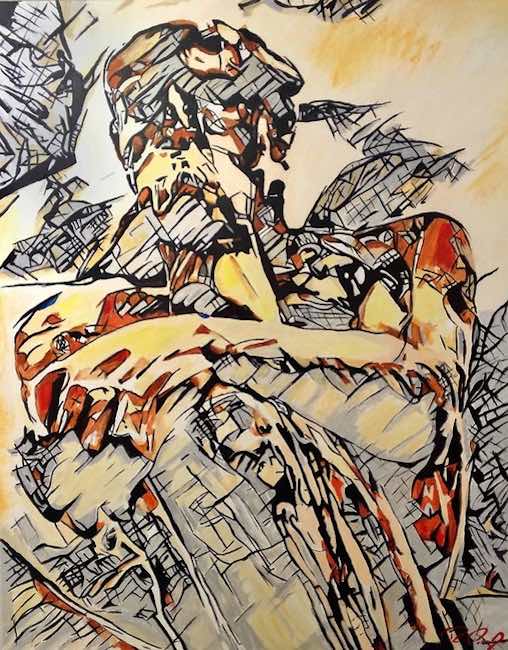
Ray Piscopo parte da due princìpi fondamentali: quello della rinuncia alla prospettiva, alla profondità e al realismo cromatico, elementi caratteristici dell’Espressionismo, e quello della scomposizione dell’immagine che si amplia nella forma attingendo al segno grafico e al contempo creando delle piccole forme geometriche che non possono non ricondurre al Cubismo.
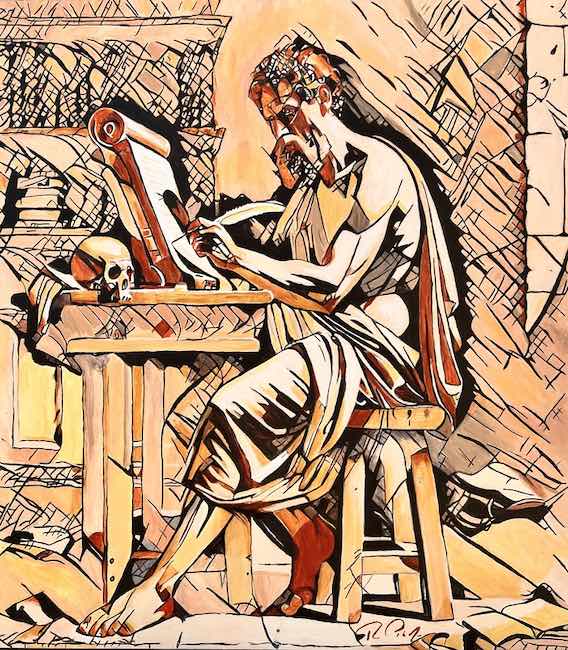
Attraverso questa capacità di modellare il suo approccio artistico sulla base del suo sentire, dell’inclinazione a riprodurre quelle sfaccettature di emozioni che appartengono alla sua natura curiosa e poliedrica, decide di dare una nuova versione di dipinti o sculture che hanno letteralmente segnato la storia dell’arte, permettendo all’osservatore di comprendere quanto la tradizione sia importante anche nel presente se guardata con un approccio aperto, ma anche di trovare il lato più attuale persino in qualcosa di apparentemente troppo tradizionale per essere considerato al passo con la contemporaneità.
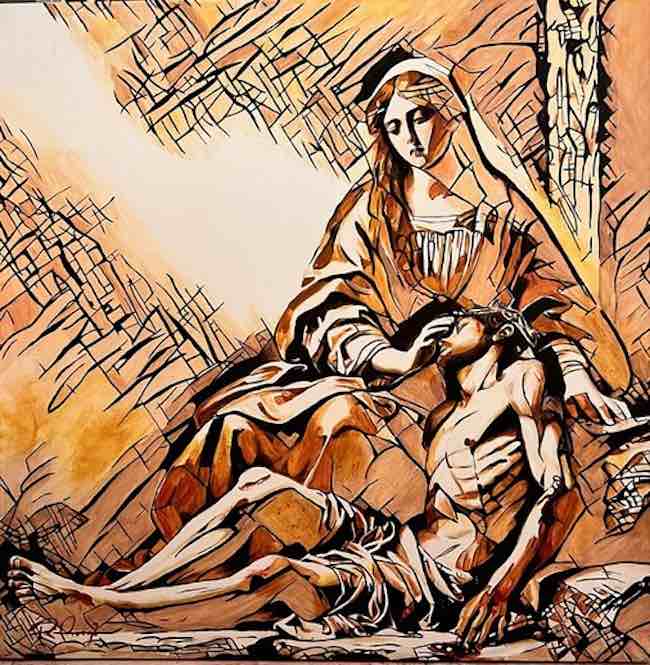
Ray Piscopo scardina questa errata convinzione facendo quasi reinterpretando in chiave Pop una scultura come La pietà, del Michelangelo, che attraverso la sua lente creativa, la sua idea dell’impossibilità di soffermarsi sulla staticità, diviene un mezzo per trovare una nuova prospettiva, quella in cui la perfezione plastica lascia spazio a un’inedita lettura, come se in qualche modo il Cristo dovesse corrispondere a tutte le sofferenze che anche nel presente affliggono l’uomo contemporaneo. La linea esecutiva di partenza è impeccabile ma poi l’artista sembra volersi distaccare da una perfezione che la renderebbe troppo eterea e distante dal sentire attuale, trasformando l’immagine attraverso l’intersecazione di linee attraverso cui creare piccole figure geometriche che frammentano ma al tempo stesso evidenziano, come nel caso del fascio di luce che giunge dal lato sinistro della tela.
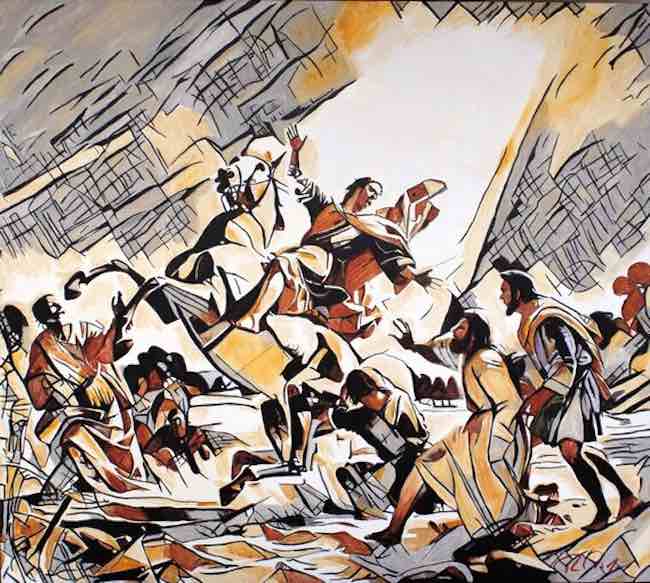
Nel dipinto La conversione di Saul invece, Ray Piscopo sembra voler fondere le diverse versioni che ne sono state date in passato, a partire da Michelangelo per finire a Raffaello passando per Luca Giordano, e ne ridisegna la struttura dandole un aspetto forse persino più solenne, esattamente grazie a quelle linee geometriche, a quel senso di irrealtà che contraddistingue la struttura pittorica dell’artista in cui il tratto grafico prevale sulla parte cromatica, perché in fondo ciò che conta davvero è l’essenziale. La figura del santo domina la scena mentre i personaggi in terra appaiono confusi, a volte indefiniti, quasi fossero lì solo e unicamente per sottolineare la solennità del momento della folgorazione da parte di Saul, San Paolo, che da quel momento trasforma e consacra completamente la sua vita alla devozione al Signore.
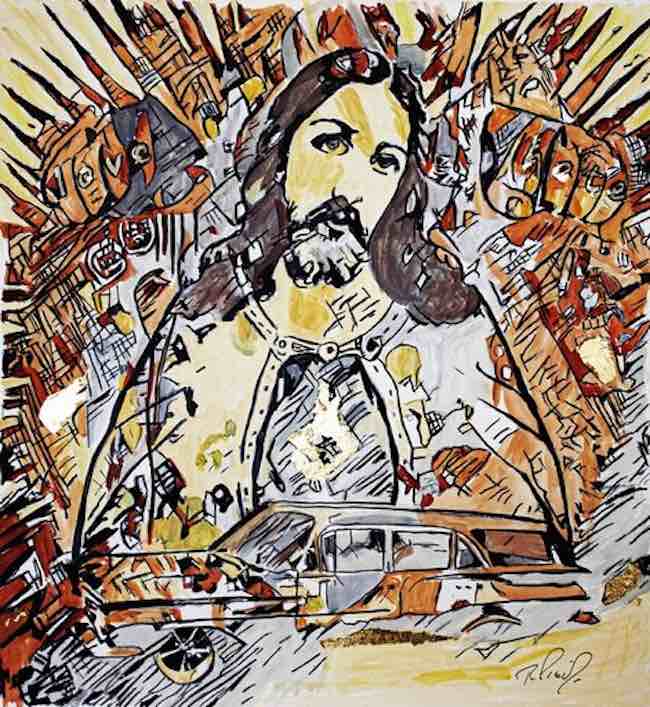
In Urban Jesus, l’unica opera di questa selezione eseguita in acquarello e foglia oro su carta, Ray Piscopo mostra ancora una volta la sua attitudine a volersi calare nella contemporaneità, a mostrare all’osservatore quanto tutto cambi pur a volte rimanendo immutato, o forse sarebbe meglio dire, quanto alcuni valori e alcune verità sopravvivano e si tramandino a dispetto del cambiamento dei tempi e del trascorrere degli anni; qui Gesù sembra emergere da un contesto metropolitano, dove l’uomo sembra essersi allontanato dal divino, dalla fede, eppure egli continua a vegliare, ad assicurarsi che gli individui restino in qualche modo legati, seppur flebilmente, a una spiritualità che può essere uno spunto decisamente più profondo e coinvolgente dei beni materiali verso cui l’individuo tende, rappresentati in questo dipinto dall’automobile di grossa cilindrata posta nella parte bassa della tela. Dietro l’immagine di Cristo l’artista pone graffiti, quell’unica voce espressiva degli ultimi delle società, di quei comunicatori di sensazioni che non hanno effettuato il percorso necessario a farsi notare dal sistema dell’arte e così esprimono se stessi sui muri delle città, sui vagoni delle metropolitane, sui sottopassaggi che le persone percorrono ogni giorno. In qualche modo emerge una rassicurazione da parte di quella figura centrale, come se fosse lì per ricordare all’uomo di continuare a essere umano, di non dimenticarsi di chi ha bisogno e di inseguire, oltre agli scopi materialistici, anche quelli interiori.
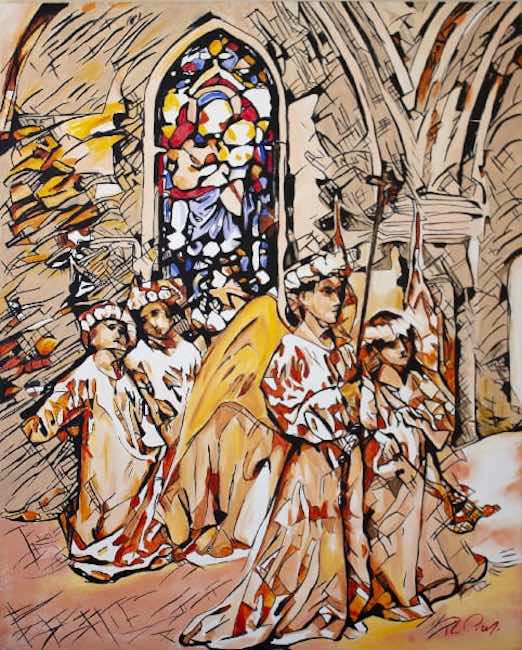
Ray Piscopo ha al suo attivo la partecipazione a molte mostre a Malta e anche all’estero e le sue opere fanno parte di collezioni private a Malta, Italia, Irlanda, Inghilterra, Francia, Norvegia, Australia e Stati Uniti.
RAY PISCOPO-CONTATTI
Email: piscopoart@gmail.com
Sito web: www.piscopoart.com/
Facebook: www.facebook.com/ray.piscopo
Instagram: www.instagram.com/raypiscopo/
The revisiting of the classics of painting through the innovative lens between Cubism and Expressionism of Ray Piscopo
Very often contemporary art seems to somehow want to distance itself from classicism, that creative and executive tradition through which the masters of past centuries left evidence of their interpretation of an academic style strongly linked to aesthetic research, where subjects had clear references to predominantly religious or mythological themes far removed from today’s artistic orientation. Yet, despite this prevailing attitude, there are some authors who feel the need not only to remember that past, but also to reinterpret it by virtue of the subjective lens and creative experience succeeded by study, analysis and deepening of all creative paths preceding that of the present. Today’s protagonist moves along this expressive line, giving in some canvases his personal vision of artworks that belong to the history of art but that, with his painterly touch, show different aspects and above all modernize while maintaining their narrative solemnity.
The tendency to change the appearance of the observed reality, giving it a completely different vision than the objective one, began to emerge around the end of the nineteenth century, that is, when the movements of decomposition of the image began to show the possibility that painting could move on innovative tracks with respect to the traditional schemes of execution. Especially Expressionism, Post-Impressionism and Pointillism decreed the possibility for artists who chose to adhere to these movements to give an unusual version of art, introducing not only emotionality, which distinguished the Expressionist theme, but also the possibility of allowing to emerge color facets that were absolutely distant from the idea of chiaroscuro, pictorial layers and colors mixed on the palette, precisely to emphasize a new way of executing works of art. The analytical approach on the interplay of colors in juxtaposition with each other, of the relevance of the association between hues and emotional impulses, and the theme of the fragmentation of the image evolved to come to dominate the art scene in the first decades of the twentieth century; Cubism and Futurism showed how decomposed and subdivided forms could take on a particular fascination from the viewer’s point of view, exerting a magnetic power toward the interpretation of paintings of both styles.
On the other hand, Expressionism had also undergone a metamorphosis from its early days, losing the intense chromatic character typical of the French Fauves, which was also taken up by northern European exponents, and moving toward greater intimism, a deeper attention to the sensations of the human being of which Egon Schiele was the master, who left a fundamental legacy to the later exponents of the London School, including the celebrated Lucian Freud. In the following years, those of the mid-twentieth century began to emerge artistic currents that aimed to go even more outside the box, but above all they understood the importance of experimentation, of mixing previous artistic experiences to give rise to completely different artistic characteristics in which the guidelines were united. This was the case of Pop Art in which Andy Warhol, its founder, decided to have an irreverent approach to icons of the cinema but also to figures of world politics by portraying them immersed in his vivid and full colors, inspired by early Expressionism. From that moment on, art lost its rigidity, there were no longer movements but rather individual authors who decided to give their own interpretation to styles, fruit of their studies, or simply the courage to let their creativity flow freely.
Exactly as the Maltese artist Ray Piscopo did, and continues to do, an engineer by profession and an artist by true and inalienable vocation, who after having deepened and attended various courses taught by the major European masters of recent years, decides to elaborate an unusual pictorial figure, fascinating precisely because it is somehow indefinable and unable to fit within a single scheme also because he himself chooses to move along different lines of production of which today we are going to explore the one that has led him to be inspired by and in some cases to take up paintings by the great interpreters of the art of the past while infusing them with his innovative touch. Ray Piscopo starts from two fundamental principles: that of the renunciation of perspective, depth and chromatic realism, elements characteristic of Expressionism, and that of the decomposition of the image that expands in form by drawing on the graphic sign and at the same time creating small geometric shapes that cannot help but lead back to Cubism. Through this ability to shape his artistic approach based on his feeling, his inclination to reproduce those facets of emotions that belong to his curious and multifaceted nature, decides to give a new version of paintings or sculptures that have literally marked the history of art, allowing the viewer to understand how important tradition is even in the present if looked at with an open-minded approach, but also to find the more current side even in something seemingly too traditional to be considered in step with the contemporary.
Ray Piscopo disrupts this mistaken belief by almost reinterpreting in a Pop key a sculpture such as The Pieta, by Michelangelo, which through his creative lens, his idea of the impossibility of dwelling on staticity, becomes a means of finding a new perspective, one in which plastic perfection gives way to a new reading, as if somehow Christ should correspond to all the sufferings that even in the present afflict contemporary man. The starting line of execution is impeccable but then the artist seems to want to detach himself from a perfection that would make it too ethereal and distant from current feeling, transforming the image through the intersection of lines through which to create small geometric figures that fragment but at the same time highlight, as in the case of the beam of light coming from the left side of the canvas. In the painting The Conversion of Saul, on the other hand, Ray Piscopo seems to want to merge the different versions that have been given of it in the past, starting with Michelangelo and ending with Raffaello via Luca Giordano, and redesigns its structure giving it a perhaps even more solemn aspect, exactly thanks to those geometric lines, to that sense of unreality that distinguishes the artist’s pictorial structure in which the graphic stroke prevails over the chromatic part, because after all what really matters is the essential. The figure of the saint dominates the scene while the characters on the ground appear confused, at times undefined, as if they were there solely and only to emphasize the solemnity of the moment of the electrocution by Saul, St. Paul, who from that moment transforms and completely consecrates his life to devotion to the Lord.
In Urban Jesus, the only work in this selection executed in watercolor and gold leaf on paper, Ray Piscopo once again shows his aptitude for wanting to immerse himself in the contemporary, to show the viewer how much everything changes while sometimes remaining unchanged, or perhaps it would be better to say, how certain values and truths survive and are handed down in spite of changing times and the passing of the years; here Jesus seems to emerge from a metropolitan context, where man seems to have drifted away from the divine, from faith, and yet he continues to keep watch, to make sure that individuals remain somehow connected, however feebly, to a spirituality that can be a decidedly deeper and more engaging cue than the material goods toward which the individual tends, represented in this painting by the big car placed at the bottom of the canvas. Behind the image of Christ the artist places graffiti, that unique expressive voice of the last of societies, of those communicators of feelings who have not gone the necessary route to be noticed by the art system and so express themselves on city walls, on underpass cars, on the underpasses that people walk through every day. Somehow a reassurance emerges from that central figure, as if he is there to remind man to continue to be human, not to forget those in need, and to pursue not only materialistic goals but also inner ones. Ray Piscopo has to his credit participation in many exhibitions in Malta and also abroad, and his artworks are part of private collections in Malta, Italy, Ireland, England, France, Norway, Australia and the United States.


